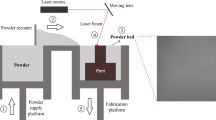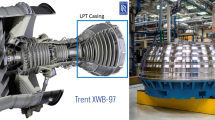Abstract
Cutting-edge chipping is a randomly happened but critical tool failure, which could seriously affect machining quality without effective and timely treatment especially in the automated machining process. Accurate and timely monitoring chipping is the first key step for properly handling edge chipping issues, while there are still gaps between academic research and industrial application as chipping initiation and propagation are always stochastic especially for milling complex structural parts with mass of ever-changing cutting conditions. This paper proposes a chipping monitoring method for automated milling process based on cutting vibration polar coordinate image features and residual neural network (ResNet) model, which lies on the change of cutting vibration signals that reveal just after an event of edge chipping has occurred. With the creatively proposed polar coordinate transform method, cutting vibration signals are first preprocessed for real-time chipping detection. The preprocessed signals with easily distinguished shape features of polar coordinate images are then employed for developing a ResNet50-based classification model. And consequently, the cutting-edge chipping could be monitored in almost real time. Experimental validation for real-time chipping detection has been conducted with the proposed method. The accuracy of No. 5~8 experiments are 92%, 88%, 83% and 84%, respectively. More importantly, the method is suited for edge chipping monitoring for milling complex structural parts, where the effects of constantly changing cutting conditions have been eliminated.











Similar content being viewed by others
References
Siddhpura A, Paurobally R (2013) A review of flank wear prediction methods for tool condition monitoring in a turning process. Int J Adv Manuf Technol 65(1):371–393
Mou WP, Jiang ZX, Zhu SW (2019) A study of tool tipping monitoring for titanium milling based on cutting vibration. Int J Adv Manuf Technol 104(9-12):3457–3471
Drouillet C, Karandikar J, Nath C, Journeaux AC, Mansori ME, Kurfess TR (2016) Tool life predictions in milling using spindle power with the neural network technique. J Manuf Process 22:161–168
Nath C (2020) Integrated tool condition monitoring systems and their applications: a comprehensive review. Procedia Manuf 48:852–863
Bleicher F, Ramsauer CM, Oswald R, Leder N, Schoerghofer P (2020) Method for determining edge chipping in milling based on tool holder vibration measurements. CIRP Ann Manuf Technol 69(1):101–104
Sadek A, Hassan M, Attia MH (2020) A new cyber-physical adaptive control system for drilling of hybrid stacks. CIRP Ann Manuf Technol 69(1):105–108
Teti R, Mourtzis D, D’Addona DM, Caggiano A (2022) Process monitoring of machining. CIRP Ann Manuf Technol 71(2):529–552
Abubakr M, Hassan MA, Krolczyk GM, Khanna N, Hegab H (2021) Sensors selection for tool failure detection during machining processes: a simple accurate classification model. CIRP J Manuf Sci Technol 32:108–119
Roy R, Stark R, Tracht K, Takata S, Mori M (2016) Continuous maintenance and the future—foundations and technological challenges. CIRP Ann Manuf Technol 65(2):667–688
Abubakr M, Abbas AT, Tomaz I, Soliman MS, Luqman M, Hegab H (2020) Sustainable and smart manufacturing: an integrated approach. Sustain 12(6):2280
Mohring HC, Esclelbachern S, Kimmelmann M (2018) Material failure detection for intelligent process control in CFRP machining. Procedia CIRP 77:387–390
Nguyen V, Melkote S, Deshamudre A, Khanna M (2018) PVDF sensor based online mode coupling chatter detection in the boring process. Manuf Lett 16:40–43
Kimmelmann M, Duntschew J, Schluchter I, Mohring HC (2019) Analysis of burr formation mechanisms when drilling CFRP-aluminium stacks using acoustic emission. Procedia Manuf 40:64–69
Jemielniak K (2019) Contemporary challenges in tool condition monitoring. J Mach Eng 19(1):48–61
Mishra SK, Rao US, Kumar S (2016) Tool wear prediction by using wavelet transform. Int J Precis Technol 6(3-4):216
Drossel WG, Gebhardt S, Bucht A, Kranz B, Schneider J, Ettrichratz M (2018) Performance of a new piezoceramic thick film sensor for measurement and control of cutting forces during milling. CIRP Ann Manuf Technol 67(1):45–48
Wan SK, Li XH, Chen W, Hong J (2018) Investigation on milling chatter identification at early stage with variance ratio and Hilbert-Huang transform. Int J Adv Manuf Technol 95(9-12):3563–3573
Fu Y, Zhang Y, Zhou HM, Li DQ, Liu HQ, Qiao HY, Wang XQ (2016) Timely online chatter detection in end milling process. Mech Syst Signal Process 75:668–688
Abu-Mahfouz I (2003) Drilling wear detection and classification using vibration signals and artificial neural network. Int J Mach Tools Manuf 43(7):707–720
Simon GD, Deivanathan R (2019) Early detection of drilling tool wear by vibration data acquisition and classification. Manuf Lett 21:60–65
Hassan M, Sadek A, Attia MH (2021) Novel sensor-based tool wear monitoring approach for seamless implementation in high speed milling applications. CIRP Ann Manuf Technol 70(1):87–90
Li Y, Liu C, Hua J, Gao J, Maropoulos P (2019) A novel method for accurately monitoring and predicting tool wear under varying cutting conditions based on meta-learning. CIRP Ann Manuf Technol 68(1):487–490
Funding
This work is supported by the National Natural Science Foundation of China (Grant No. 52090053, 52105432 and 52130506), the National Key R&D Program of China (Grant No. 2018YFA0702803), the Science and Technology Innovation Foundation of Dalian (Grant No. 2021RD08, Grant No. 2022JJ12GX027 and 2021JB12GX010).
Author information
Authors and Affiliations
Corresponding author
Ethics declarations
Competing interests
The authors declare no competing interests.
Additional information
Publisher’s note
Springer Nature remains neutral with regard to jurisdictional claims in published maps and institutional affiliations.
Rights and permissions
Springer Nature or its licensor (e.g. a society or other partner) holds exclusive rights to this article under a publishing agreement with the author(s) or other rightsholder(s); author self-archiving of the accepted manuscript version of this article is solely governed by the terms of such publishing agreement and applicable law.
About this article
Cite this article
Jiang, Z., Wang, F., Mou, W. et al. Method for edge chipping monitoring based on vibration polar coordinate image feature analysis. Int J Adv Manuf Technol 130, 5137–5146 (2024). https://doi.org/10.1007/s00170-024-12981-6
Received:
Accepted:
Published:
Issue Date:
DOI: https://doi.org/10.1007/s00170-024-12981-6




